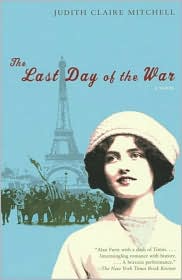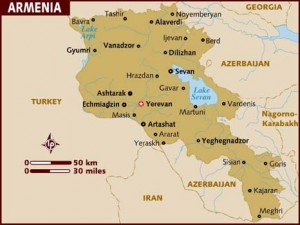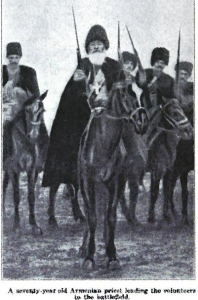“The Turks are killing hundreds of thousands of people, everyone knows it, and the only way Americans come to their aid is by cleaning their plates (‘Remember the starving Armenians’), gobbling down every last slice of peach pie, slurping up every last drop of cherry ice cream. America gorges on behalf of dark, swarthy Armenia but storms into battle [during World War I] for blond, blue-eyed Belgium.”
 Although most Americans know that World War I began in 1914, far fewer know that while that war was being fought in Europe, a million Armenians were being exterminated by the Turks. In a series of massacres over a period of more than twenty years, most notably between 1894 and 1915, the Armenians were forced from their land, marched across barren plains under deplorable conditions, and subjected to depredations from which death was often a merciful release. Hope came at the end of World War I, when Armenia was promised self-rule and the Turks were forced by the world community to punish those responsible for the massacres, but by that time many killers had escaped to Europe. Turkey indicted them, but few were punished.
Although most Americans know that World War I began in 1914, far fewer know that while that war was being fought in Europe, a million Armenians were being exterminated by the Turks. In a series of massacres over a period of more than twenty years, most notably between 1894 and 1915, the Armenians were forced from their land, marched across barren plains under deplorable conditions, and subjected to depredations from which death was often a merciful release. Hope came at the end of World War I, when Armenia was promised self-rule and the Turks were forced by the world community to punish those responsible for the massacres, but by that time many killers had escaped to Europe. Turkey indicted them, but few were punished.
Author Judith Mitchell seizes on the fact that many Armenian-Americans, referred to as “hyphenates” by President Wilson, fought in the war in Europe but were also committed to making Turkey pay for its crimes against their families and culture. She creates a fascinating plot which brings to life the efforts by Armenians in Europe and America to address the wrongs done to them by bringing the Turkish leaders of the massacres to justice, either legal or ad hoc.

Doubleday (Dub) Hagopian, given his first name when he arrived in the United States as a small child, is from Providence, Rhode Island, an American living in a city with a sizable Armenian population. Speaking both Armenian and English, he grows up in the Armenian culture but does his duty as an American by fighting in the war in Europe, and working as a translator during the Paris Peace Conference. He is also part of a secret society of Armenians, dedicated to capturing three leaders of the massacres who have escaped to Germany, along with the former police chief of Adana, Kerim Bey, now in Paris. Bey was responsible for locking the doors to the church where Armenian families were worshipping, and then lighting it on fire, burning to death all the men, women, and children who were inside.
Yale White, formerly Yael Weiss, an adventurous eighteen-year-old from St. Louis, meets Dub briefly when he is in St. Louis to acquire weapons, and is so smitten she then lies about her age and religion and changes her name in order to follow him to Europe, where she works as a “canteen lady” for the YMCA. She and her unconventional best friend, Mary “Brennan” White, who pretends to be her sister, presage the “flapper” attitudes that will develop after the war, while Dub and Raffi Soghokian, an acquaintance from Providence, serve the serious cause of Erinyes, a secret organization seeking to avenge the massacres.
As the action m oves forward, the author presents flashbacks, which reveal the terrible history of the Armenians, not in generic terms, but in its effects on individuals in the novel. Yale’s Jewish background, the Irish Catholic background of Mary “Brennan” White, and the fundamentalist background of Rev. Alban Bliss and Amo Wilson, leaders of the YMCA, broaden the scope of the novel and put the Armenian massacres into historical perspective. Though the Irish suffered under the British, and the Jews will later suffer massively under the Germans, the western world knows little about the systematic extermination of a million Armenians.
oves forward, the author presents flashbacks, which reveal the terrible history of the Armenians, not in generic terms, but in its effects on individuals in the novel. Yale’s Jewish background, the Irish Catholic background of Mary “Brennan” White, and the fundamentalist background of Rev. Alban Bliss and Amo Wilson, leaders of the YMCA, broaden the scope of the novel and put the Armenian massacres into historical perspective. Though the Irish suffered under the British, and the Jews will later suffer massively under the Germans, the western world knows little about the systematic extermination of a million Armenians.
The plot is exciting, as the love story of Dub and Yale develops and Yale commits herself to Dub’s cause. Europeans with whom Yale, Dub, and Brennan reside are also dedicated to bringing the leaders of the genocide to justice, while, at the same time, saving children who have been orphaned by bringing them to France and finding new homes for them in the United States. One of the older orphans, Shushan, herself has a memorable story which few readers will be able to forget. Interspersed throughout the novel, these stories of atrocity make the plight of the Armenians particularly vivid.
 The novel depends to a great extent on coincidences to resolve the action, with the right people being in exactly the right places at the right times, and the story loses its focus, occasionally. The use of more foreshadowing, which would unify the plot and prepare the reader for the twists and turns of the action, would have strengthened the plot line by reducing the reliance on coincidence. Though the characters are at a critical period of history, they are not very introspective, and at several points, the author steps out of “character” to teach the reader history—the basics about how World War I got started, along with details of the peace treaties at the end of World War I, which promised sovereignty to the Armenian people.
The novel depends to a great extent on coincidences to resolve the action, with the right people being in exactly the right places at the right times, and the story loses its focus, occasionally. The use of more foreshadowing, which would unify the plot and prepare the reader for the twists and turns of the action, would have strengthened the plot line by reducing the reliance on coincidence. Though the characters are at a critical period of history, they are not very introspective, and at several points, the author steps out of “character” to teach the reader history—the basics about how World War I got started, along with details of the peace treaties at the end of World War I, which promised sovereignty to the Armenian people.
The novel is fast paced and compulsive reading, however, and it brings attention to a subject which has only rarely been the subject of novels. As the reader’s knowledge and understanding of the Armenian people and their history grows, and as the relationship between Dub and Yale blossoms, Dub’s comment in a Catholic church takes on special meaning. “Armenians don’t kneel,” he says to Yale. “Neither do Jews,” she replies.
Notes: The author’s photo appears on http://www.english.wisc.edu, where she teaches creative writing.
The map of Armenia is from http://www.lonelyplanet.com
The photo of Armenian Resistance fighters in 1918, led by a seventy-year-old priest, appears as part of an entry on http://en.wikipedia.org
